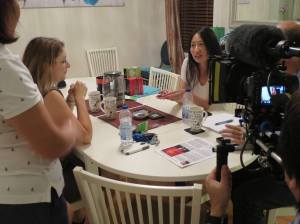Many have been asking me, “What’s going on?” “Why is it taking you so long to come back to (insert activity here)?” “Where in the world are you?”
Those of you who read my previous post know that I’m not living a normal life right now. I wish I could tell you I’ve impulsively ran off to the Caymen islands (which I once was about to do). But no- I’ve been diagnosed with sudden deafneass so I’ve moved in with my family. I’m working from home, only making way to the office every once in awhile. I can still hear a bit, but only loud and sharp sounds. I can’t really understand speech anymore. I’m becoming a better lipreader. But it’s hard for me to get around or do many things; I’ve stopped dancing as well as all of my other social activities and projects. My focus right now, is on getting ready to get a cochlear implant.
What is a cochlear implant?
When your ear is damaged and can’t process sound information, hearing aids are of no use. A cochlear implant (CI) consists of an electronic device surgically implanted behind the ear, under the skin. There is an external device worn behind the ear to send sound to the internal device. The device then makes the sound bypass the ear and sends signals stimulate the hearing nerve. The signals then reach the brain, which does the job of converting the signals into sound.
The Cochlear Implant Process
“So go ahead, get this surgery done already, instead of making yourself miserable at home.”

I wish it were that easy. The process of getting a CI involves many steps. Naturally, the first step is to understand what a CI is, and what you are getting yourself into. Thankfully, I know a few people who have gone through this. My friend Chantal, who got her implant 13 years ago, came over a few weeks ago to give me a runthrough of the whole procedure. We were happy to accommodate the crew from Picture This Productions, who will be integrating bits of my story into their upcoming documentary Seen and Heard. The film follows the cast and crew of a theatrical production I was part of this past spring. It showcases teamwork, determination, and captivating stories – please support the film by liking this Facebook page .
Over the next week, I will be talking to a few more people regarding their experience with CIs, and reading up as much I can about it. The outcome of this surgery is different for everyone. Some end up hearing extremely well with it; others, not as well. The reason for this is that since it’s the brain that processes the sounds, the level of success depends on what that person can make of the sound. Therefore, if a person was born deaf and has never heard sound before, a CI wouldn’t be much help.
I’ve completed the first medical step, which was to get a CT scan. This will help the doctors determine if there is any damage that they need to be careful of during the surgery. I have it with me, but I have no clue as to what it demonstrates. If anyone knows how to read CT scans let me know!
All future steps will involve me travelling three hours to Quebec City, the only city in the province where CIs are allowed to be performed. Politics in Quebec are so complicated. The next step for me is to go to Quebec City for hearing test, and to meet the surgeon who will be operating me. Stay tuned.









1 Comment
Add Yours →Thanks for sharing and keeping us updated, Kim! Thinking of you.